Memes: The Quintessential Post-Modern Art Form

Few people would say that memes are high-brow or avant-garde forms of art, and yet if we examine the facets that define post-modernism we find that memes fit the bill more perfectly than perhaps any other artistic medium.
Before we dive in, I ought to clarify that when I use the word “meme” I am not, for the most part, referring to its original, more scientific definition: "a viral idea, behavior, or style that spreads from person to person within a culture." I am going to be speaking more specifically about the humorously-captioned images we see all over the internet (although, of course these are undoubtedly prime examples of that broader category of viral trends).
Now, to refresh your memory-- in case you've forgotten that long ago highschool art history class-- post-modernism is an artistic movement generally defined by irony, irreverence, inter-textuality, self-referentiality, and metafiction, as well as a general attitude of skepticism, cynicism, and pessimism. Each of these qualities are absolutely inseparable from those captioned images which we have come to define as "memes."
Irony
Irony, of course, is the basis of almost all meme humor, and it is the only truly essential quality to a meme. Irreverence, inter-textuality, self-reference, metafiction, pessimism, and all the rest are all used within memes as a method of creating ironic humor, so they are secondary qualities to the primary quality of irony. By irony I mean “the expression of an idea using language which normally signifies the opposite meaning” (e.g. sarcasm) or “something that runs contrary to our expectation.” Memes frequently play upon our expectations to create humor, and the reason for this is actually rooted in the psychological mechanism and evolutionary purpose behind humor in general.
In 2011, three researchers, Hurley, Dennett and Adams, published a book titled Inside Jokes, reviewing previous theories of humor and many specific jokes. They suggest that humor evolved because it strengthens the ability of the brain to find mistakes in active belief structures. For them, humor is the pleasure of detecting mistaken reasoning. This opinion is corroborated by the growing popularity of "Benign Violation Theory," a well-tested hypothesis which has risen to the forefront of humor research. According to the theory, humor can only occur in the presence of three conditions: 1) something threatens our sense of how the world "ought to be" 2) the threatening situation seems benign 3) we see both interpretations simultaneously. Irony, which deliberately subverts our expectations and pre-conceived notions, is the manner in which memes threaten our sense of how things ought to be. If we find this intellectual violation to be benign—it doesn’t offend us, annoy us, or frighten us— then we will find the irony humorous. The measure of its humor will be to what extent the irony is able to benignly subvert our expectations and preconceived notions. The pleasure of detecting mistaken reasoning, of learning, is achieved by this intellectual subversion.
Irreverence
The following four memes are all "irreverent" in the sense that they are deliberately crass, offensive, or perverse. Irreverence is extremely common in memes, but it cannot stand alone. Something crass, offensive, or perverse is not funny in and of itself, because in order for something to strike us as funny we need to perceive its moral or intellectual violation as being benign/ ironic. Take a look at these four memes, and I will provide some additional commentary beneath.

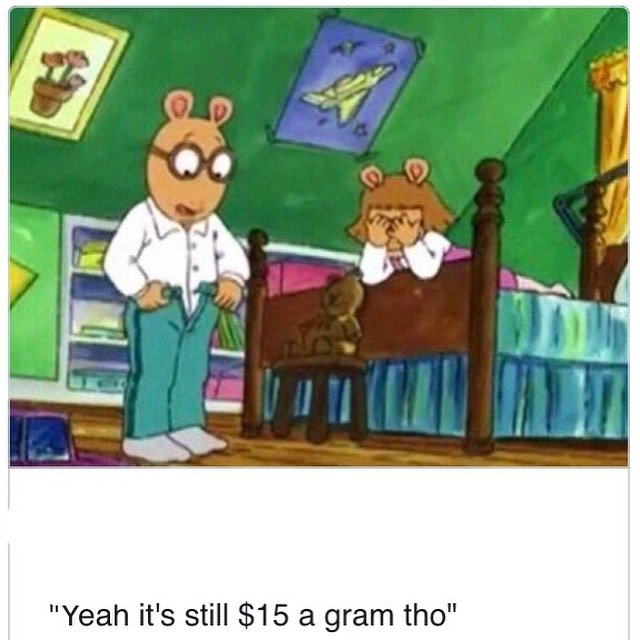


While each of the above memes is irreverent, none of them depend solely upon irreverence for their humor. Each of them employs intertextuality in order to create additional humor. What is "intertextuality" you ask? Good thing that's our next section...
Intertextuality
In literature, intertextuality is a deliberate and conspicuous relationship between two texts. One might think of Jorge Luis Borges, who within his own short stories made frequent references and allusions to other literary works like Don Quixote and The One Thousand and One Nights. One might also think of classic hip hop music, in which sampled audio creates an intellectual bridge between the original sample source and the resulting musical pastiche. Memes, similarly, rely upon cross-reference between a variety of sources, whether those sources be in the real world or the realm of fiction. More often than not, these intertextual references are employed to ironic effect. In the memes above, for example, we have an Obi Wan Kenobi quote taken out of context in order to comment, offensively, upon 9/11. We have the innocent children's television character Arthur (a favorite of meme makers), captioned with a quote that changes him into a sexually exploitative drug dealer, and in another Star Wars reference, we have a Yoda quote placed in a context which reverses the meaning from innocent wisdom to comical perversity.
There are many, many more examples, however, as intertextuality is one of the most common methods of meme irony and humor. Many of these examples are more complex than the ones above. Rather than simply move a fictional character into an ironic context, some intertextual memes achieve the same effect by merging multiple fictional elements into a singular scene, changing the meaning of multiple elements instead of just one.
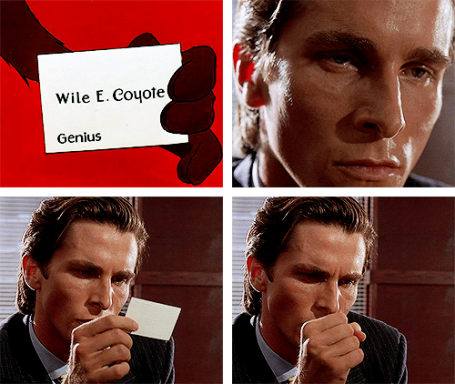

.
.
.
.
Intertextuality also exists within the confines of meme culture, in the sense that many memes reference other memes and create a pastiche out of existing meme tropes. Which brings me to my next topic:
Self-Referentiality
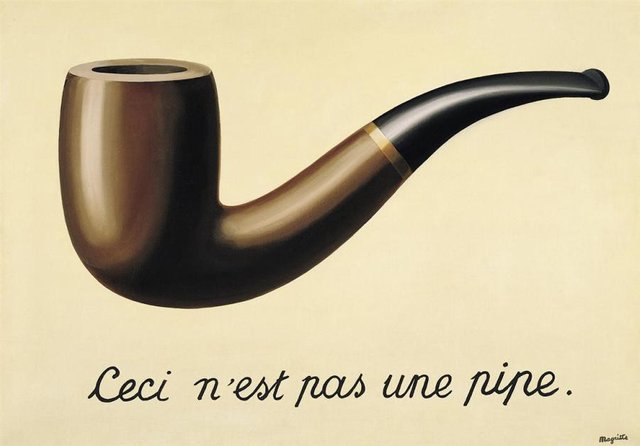
In classic post modern art, self-reference emerged as a rejection of realism, which various artists believed to be fraudulent in its attempt to imitate and stand in for real life. The painting above by René Magritte, title The Treachery of Images, seeks to express this concept by declaring beneath the image of a pipe "this is not a pipe." The same rejection of realism became prevalent in literature as well, with many writers choosing to make their stories reference themselves as such. Consider the opening of Kurt Vonnegut's crowning achievement Slaughterhouse Five: our narrator begins by saying "All this happened, more or less," and he goes on to describe how he came to write the very novel you're reading. The narrator deliberately reminds you that this is a fictionalized account of something real, that it should be regarded as art and not as the event itself.
Memes apply self-reference to a less philosophical effect. Memes are inherently rooted in viral trends, and they create thematic, formal, or metaphorical structures within which they must operate. The "Crying Jordan" meme is perhaps one of the simplest examples of a classic meme metaphorical structure. Obviously, Jordan crying represents sadness, loss, "taking an L," et cetera, and so the meme revolves around placing Jordan's crying face over the faces of people that have recently suffered some sort of defeat. In order to add humor and novelty to the repetitive joke, people will often deviate from the norm by photoshopping Jordan's face onto unexpected subjects, like in the following meme from the 2016 presidential election:
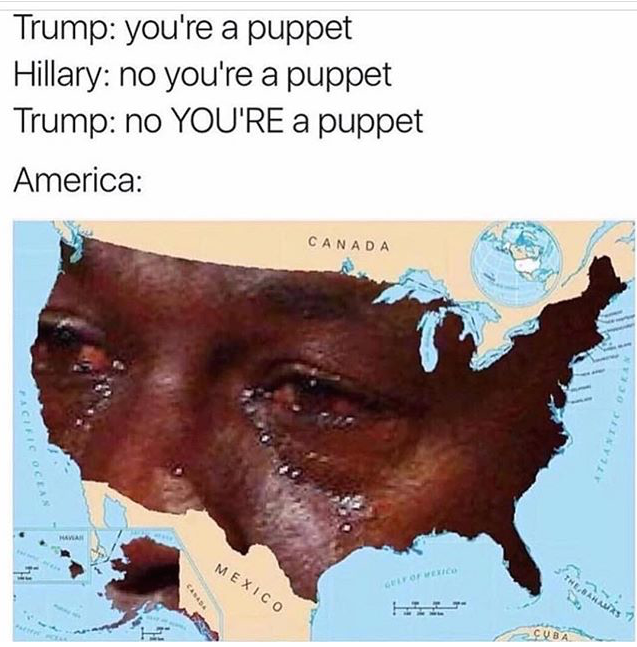
The Crying Jordan meme is one of the simplest examples. Self-reference in meme culture is extremely diverse, though, and behind irony it is perhaps the most prevalent and definitive aspects of meme humor. One of my personal favorites is the Kodak Black "can we listen to something else?" meme:
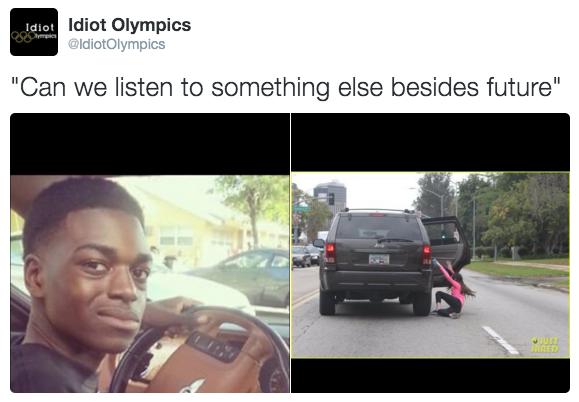
Future is of course a popular hip hop artist, so many viewers could sympathize with the idea of wanting to throw out a passenger who wasn't feeling the vibe. The humor here comes from several sources. Kodak's facial expression is funny and relatable in and of itself, and there's also an irreverent humor in the idea of throwing your nagging passenger out of a moving car simply because they don't like your music. The meme, however, would not be able to perpetuate itself solely off of repeating this same joke over and over. No one would laugh if we simply replaced "Future" with our own favorite artists. Subsequent iterations of the meme instead derived their humor through absurdity, creating ironic deviations from the formal structure which had already been created.

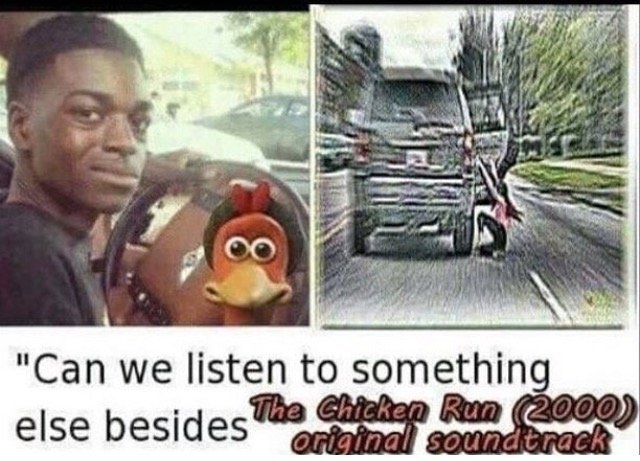
.
.
.
Similar examples of self-reflexive humor abound, as all memes are essentially based in some formal structure which can be remixed and subverted. Take, for example, the recent "Car Salesman" meme. It began when twitter user @OBiiieeee tweeted the following:
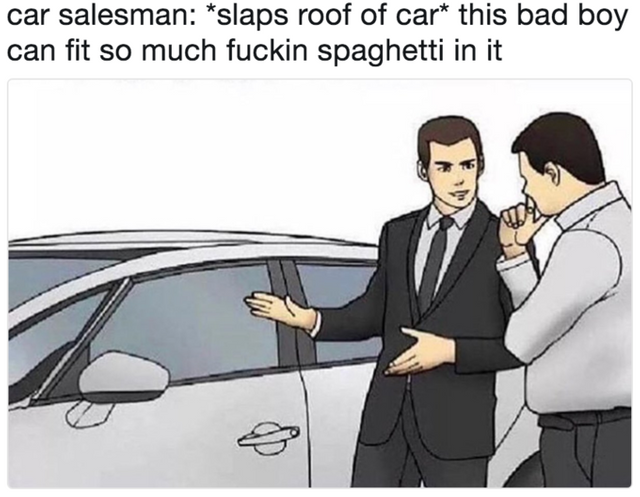
The meme quickly evolved, with subsequent iterations all deriving their humor by commenting upon and diverging from the formal structure they were simultaneously helping to construct:
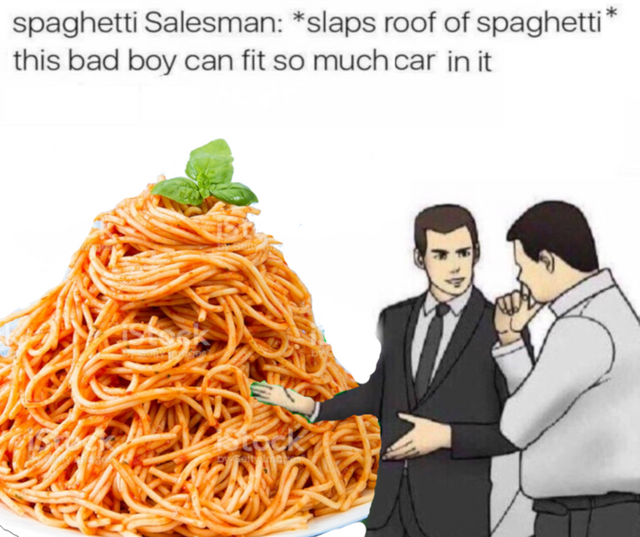
.jpg)

All of these memes derive their irony and humor exclusively from the viewer's pre-existing knowledge of the formal structure being employed. If we are unfamiliar with the meme, then there is no expectation for them to deviate from and no irony to be had. The last meme, above, is perhaps the most extreme example, in that it not only references the car salesman meme but also includes an intertextual reference to the "It's Free Real Estate" meme. For the meme-obsessed, this makes it all the more humorous. For the uninitiated, it makes it all the more incomprehensible.
Skepticism, Cynicism, and Pessimism
The attitude of post-modern art is associated with disillusionment-- a disillusionment with enlightenment ideals of human agency, social progress, the benefits of technology, and the rational nature of the universe. Post-modern art is predominantly nihilistic, favoring a view of reality in which humans are fragile, cruel, and pathetic creatures, social progress is moving in a largely negative direction, technology is a greater foe than friend, and the universe itself is a chaotic, irrational, and unsympathetic landscape. Memes, for the most part, seem to endorse this cynical and pessimistic outlook, although they frequently present these depressing ideals in an ironic fashion. In this way, it almost appears as if memes are trying to assuage our feelings toward meaninglessness. They tell us, "it's okay that reality is a hellscape-- in fact it's kind of funny." Take a look at the following pessimistic memes, and consider what life lessons they are trying to convey to you:
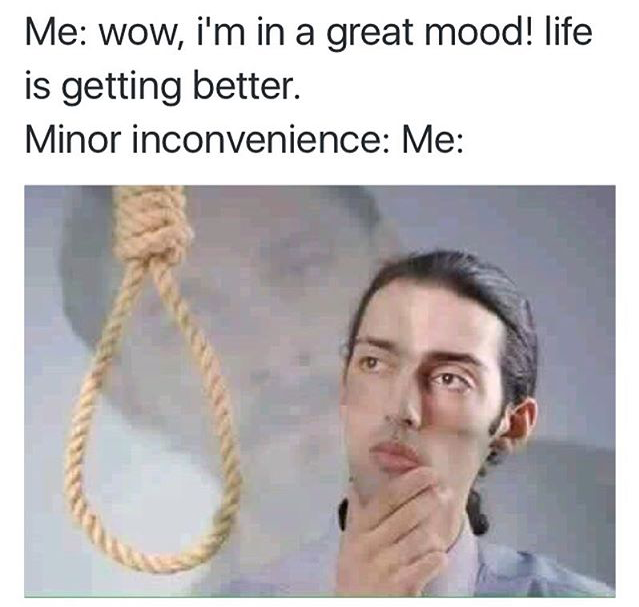
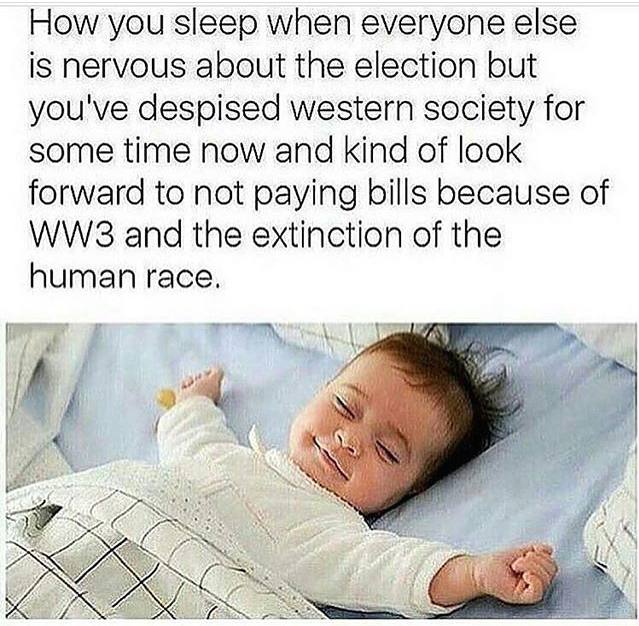
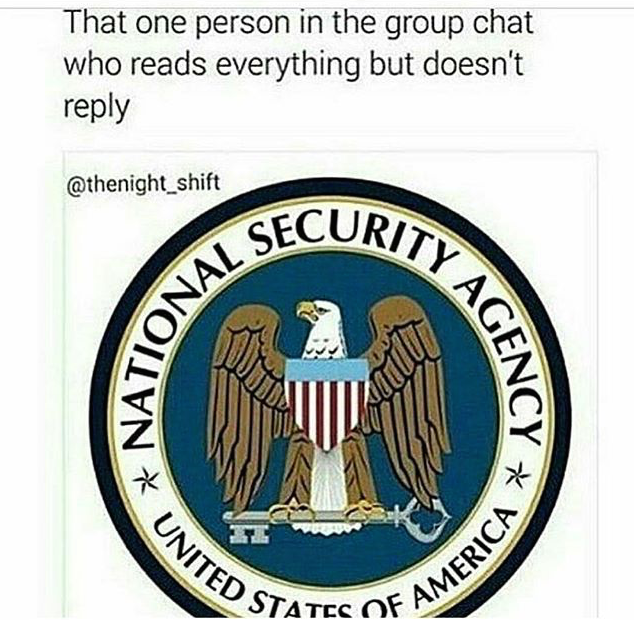
The first meme above, where a minor inconvenience leads to contemplations of suicide, is ironic in the sense that obviously minor inconveniences are an absurd reason to consider suicide. There is actually some value to this message, because for people suffering from depression even small things can grow in proportion and seem more insurmountable and devastating than they actually are. Even though the meme reinforces the idea that suicide is a possible solution to our problems, it makes an argument that suicide is an absurd and illogical choice. The pessimistic message, since it is presented ironically, actually creates an optimistic effect on the viewer.
The second meme, featuring a sleeping baby, was made during the 2016 US presidential election and expresses a contentedness with the prospect of global annihilation. Essentially, the speaker is so cynical in their outlook of society and the future that they are perfectly happy to see the entire human race wipe itself out in WWIII. Again, while this meme reinforces a cynical outlook on society, its ironic effect is to inspire optimism in the viewer in spite of the negative societal environment.
The third meme playfully references the fact that the NSA collects cellular data from all Americans. It's a disturbing concept to think that a government agency is monitoring your communications, but the concept is made benign here by its humorous intertextual association with the preexisting "that one person in the group chat" meme.
As we can see, cynicism and pessimism are prevalent in memes just as they are in all of post-modern art. Memes use these attitudes to a unique effect, however, because their constantly ironic presentation forces us to modify or reject the same pessimistic philosophy which forms the basis of the joke.
The Problem with Postmodernism
As we have now shown, memes are not only valid examples of post-modern art, but are, in fact, the most post-modern of any form of art. This may seem like high praise for memes, but before we start putting Scumbag Steve images in the Louvre we should consider to what extent the popularity and ubiquity of memes is a good thing. It may be the case that memes are the most frequently digested form of art in the modern world, which is troubling because of how briefly they affect us and how inapplicable their humor is to real world problems. In our earlier discussion of irony we presented the idea that the purpose of humor is to expose and correct examples of flawed reasoning-- laughter is produced by an ironic form of education. The problem with memes is that, for the most part, they frequently reinforce our preconceived notions without offering any broader philosophical or intellectual message.

The above meme, for example, tells us absolutely nothing which might correct some form of flawed reasoning. All it does is acknowledge that giggle-fits are something that exist, and it pairs this notion with an image of Kardashian sisters laughing. Obviously, not all memes are this inane, but the trouble is that most memes tend to comment more on their own formal structure than on broader issues. The salesman memes, for example, are hilarious, but only because of an absurdity that they create within their own paradigm. They do not alter our perspective on anything outside the realm of that particular meme. There are only a small percentage of memes which are able to accomplish this. One example are the fact-based political memes, which are generally not humorous or artistic but are simply easily-shareable forms of political propaganda. The other prime example are the cynical and pessimistic memes, which can have the ironic effect of assuaging our discomfort with nihilism.
The simplistic humor of memes coupled with their context-specific meanings give them a short shelf life. Once a meme has been seen once, it rapidly loses its ability to elicit laughter, because our cognitive web has already adjusted itself to incorporate the minuscule modification offered by the meme. Unsurprisingly, the memes that everyone knows this week will be forgotten, or at least irrelevant and unhumorous, within a couple weeks. Who now remembers the Cash Me Outside girl or the wildly diverse FML stories? They were both flavors of the week at one time, but they quickly used up their novelty and were forgotten. The Cash Me Outside girl briefly reignited her relevance by making a rap album, but the piss poor quality of the music did little to perpetuate her fame.
The intersection between meme popularity and pop music, as represented by the Cash Me Outside girl, is indicative of a broader problem in our culture. Our attention spans have shrunk dramatically while at the same time our desire for and access to instant gratification has dramatically increased. Our music, movies, and every other aspect of our pop culture have undergone what we might call meme-ification, a fast paced, post-modern series of self-referential novelties that tell us nothing particularly meaningful but are churned out fast enough to appease our short attention spans. Instagram celebrities, rappers, and comedians pop up and disappear faster than we can keep track of, and the duration of their fame can be measured by their capacity to alter their own formal structure without leaving it behind entirely. This is why Drake has remained hugely popular while countless other rappers have popped up then quickly faded into obscurity. Drake, like a human meme, has perfected the ability to remix his own formal structure, appropriating new rap styles and influences in order to become something novel while still capitalizing on his pre-existing fame. He has even gone out of his way to meme-ify himself-- with the video for his hit song Hotline Bling, he hoped and expected that certain aspects of the video would be turned into memes. Of course the video ended up becoming one of the most prolific meme sources of all time, and the diversity and ubiquity of the memes became an extremely effective and low-cost marketing strategy.
Perhaps the greatest problem with this meme-ification is that our standards for what constitutes good art have fallen dramatically. We are more interested in novel reinforcements of a pre-existing worldview than we are in genuine novelty and shifts in paradigm. We would rather find new varieties of familiar trap music than find meaningful or complex music which might otherwise stand the test of time. We would rather see Kermit the frog in an ironic captioned image than see Kermit in an actual film or television show. We would rather see an image of two friends laughing, captioned "when you and your friend are laughing," than actually converse and laugh with a friend. All of this is problematic, but, if memes succeed in holding back that dreadful nihilism, if they manage to assuage our depression and anxiety with a meaningless society and a meaningless world, then perhaps they are more valuable than I am giving them credit for. Maybe a meme a day can keep the psychologist away, or maybe they're slowly turning us into zombies with the attention spans of goldfish. In any case, I'm not about to quit looking at memes, and if you haven't begun then you should come down and join me. We all float down here. It's tremendous.

Cover Photo: Image Source
All memes courtesy of knowyourmeme.com and instagram pages @trashcanpaul @cabbagecatmemes @fuckitimarobot and @shitheadsteve
Esto se ha vuelto muy viral para hacer reír a las personas los memes son una atracción en esta nueva época
Memes trigger several thoughtful processes, many bordering on irony as you here allude.
Personally however, i have not previously thought if them as art, but you here make a very strong case, in that regard, in this elaborate but insightful read.
may i like your post i have to learn a lot with you buddy
By. @adit123
You have certainly made a strong case to take memes more seriously (well, like all art forms, those that really deserve it, there is some crappy stuff out there).

I was actually getting tired of the cardib picture. They have done so much with that image!
Someone even put a Maduro head on. The good thing about memes, and i guess any cultural critic would agree, is that their potential to become "viral", their versatility and their ephemerality (if the word fits), provide valuable information about people's interests across cultures or social groups and how from the basic joke other more political issues start permeating and being incorporated into the whole scheme, which also speaks volumes of what people care about at a given moment.
It's a fascinating thing and you have done a wonderful job here putting something so apparently innocuous and worthless into proper perspective.
I think the meme is a very simple yet very contemporary art that has a very high meaning. The element of humor and criticism is very much inherent in the existence of a meme sir @youdontsay
Excellent information, totally agree
Excellent article. I really liked it. Good luck to you and Love.
Con la mayor exposición de las redes sociales los memes se han hecho mucho más famosos a medida que las personas las utilizan y como dices los memes y su principal caracteristica se basa en la Ironia y la Sátira a los personajes ó situación en que se presentan. Saludos @youdontsay y feliz inicio de semana